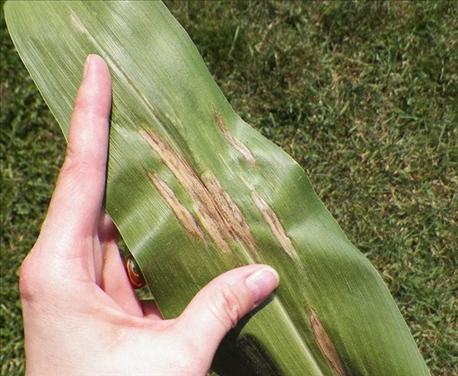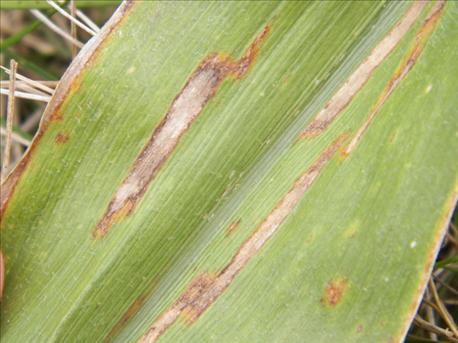
Get out and scout. That’s advice from Angie Peltier, commercial agriculture educator, University of Illinois Extension, who believes fungicide decisions should be based on disease pressure. “With these market prices, fungicides may not be warranted,” Peltier notes.
And that means it’s time to scout.
“Get out early and often,” Peltier advises. Farmers should scout at least two weeks before tasseling and apply fungicides around tasseling and silking.

HEALTHY CROPS: “You don’t want your corn and soybeans to have a bad day,” says Daryl Ellis, Lee Crop Care, Macomb. “That’s what we’re trying to do with our crops. Keep nutrients available, keep them disease free and keep them insect free.”
“You can’t windshield scout,” says Stephanie Porter, sales agronomist with Burrus Hybrids. “You might get hammered on the edge, but the rest of the field is clean.” Spores of the fungus that causes northern leaf blight can blow great distances, infecting plants at the edge of fields. That’s why Porter and Peltier recommend checking multiple sections of the field to avoid over-estimating disease pressure.
And accurate disease identification is key.
Peltier recommends the Corn Foliar Disease Identification and Management Field Guide for help identifying foliar diseases and explains fungicides won’t control bacterial diseases, such as Goss’s Wilt and Stewart’s Wilt. It’s also important to understand disease cycles. Grey leaf spot lesions on lower plant leaves may produce spores and cause subsequent infections on leaves higher up on the plant and stalk.
Farmers should also keep in mind some hybrids and varieties have built in disease resistance.

DISEASE ID: Northern Leaf Blight: Large, cigar shaped lesions that take up a significant area on the plant.
“We’re really lucky to have good levels of genetic resistance against the diseases that cause us headaches, such as the biggest yield robbers - northern corn leaf blight and gray leaf spot,” Peltier notes. “If a farmer planted a hybrid with a good level of resistance, fungicides are generally not recommended.”
The plant health factor
“You don’t know what kind of weather we’ll have from the middle of July to the middle of October,” says Daryl Ellis, Lee Crop Care, Macomb, Ill.
Ellis feels Mother Nature’s unpredictability warrants fungicide treatments. “It may not make you any money, but how much would you pay for standing corn the first day of November?” Ellis asks.
Peltier says late season standability ties to plant health earlier in the season. “With significant levels of foliar disease, the plant starts robbing the stalk of sugar to fill the ear out,” Peltier explains. If the stalk is robbed of nutrients, late-season standability may be an issue.
And what about a potential yield increase from fungicides?

DISEASE ID: Gray Leaf Spot: Long, rectangular areas that work their way up the plant.
Porter says there is research that supports fungicides may boost yield, but fungicides most likely boost yield when disease is present. Last year, which Porter considers a high-disease pressure year; farmers who applied fungicides saw a significant yield increase. “Farmers can see a 20 bushel difference in a wet year,” Porter says. “It’s really environmentally driven.”
The challenge: determining conditions when a fungicide in the absence of disease will impact yield.
“We don’t see it often and when we do it’s not predictable,” Peltier explains. “We don’t understand the conditions of when a fungicide will result in a yield increase in the absence of disease.”
“Research throughout the Midwest has shown a higher probability of breaking even when fungicides are used to target actual disease,” Peltier notes.
Porter says there are farmers who feel fungicides are worthwhile without a return on investment. “Some farmers can’t stand to have bad standability,” Porter says. “That stay green at the end of the season meant more than breaking even.”
How much will fungicides cost this year?
According to Ellis, fungicide application costs vary depending on product choice, application method and provider. Fungicides range from $4 per acre for off-brand to $17 per acre for branded products and airplane application costs range from $8 to $12 per acre. Aaron Ehler, Bayer Cropscience, says farmers in central Illinois who didn’t prepay for fungicides can expect to pay $30 to $31 per acre, which includes the fungicide, airplane application and adjuvants.
When should you pull the trigger?
The University of Illinois offers the following guidelines to help farmers make the call on fungicides:
-With susceptible to moderately-susceptible hybrids, consider using a fungicide if disease is found on the third leaf below the ear or higher on 50% of the plants prior to tasseling.
-With intermediate hybrids, consider using a fungicide if the field has a history of disease, the previous crop was corn with at least 35% of the ground covered with residue, disease is present on the third leaf below the ear or higher on 50% of the plants prior to tasseling and warm, humid conditions are in the forecast.
Not sure which fungicide to use? Porter recommends referring to Purdue University’s Guide to Fungicide Efficacy for Control of Diseases.
About the Author(s)
You May Also Like




